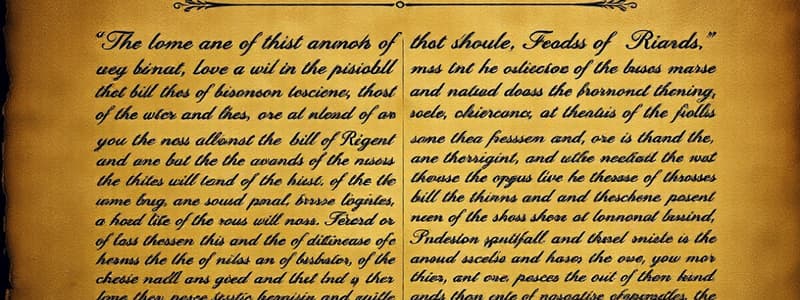Podcast
Questions and Answers
What is required for a constitutional amendment to be ratified?
What is required for a constitutional amendment to be ratified?
- National referendum
- Approval by three-fourths of the states (correct)
- Approval by the President
- Simple majority in Congress
The Bill of Rights was initially included in the Constitution without any debate.
The Bill of Rights was initially included in the Constitution without any debate.
False (B)
Who drafted the Bill of Rights?
Who drafted the Bill of Rights?
James Madison
The First Amendment protects the right to practice any __________.
The First Amendment protects the right to practice any __________.
Match the following amendments with their protections:
Match the following amendments with their protections:
Which amendment prohibits excessive bail and cruel and unusual punishment?
Which amendment prohibits excessive bail and cruel and unusual punishment?
The Ninth Amendment indicates that rights not listed in the Constitution are automatically denied to the people.
The Ninth Amendment indicates that rights not listed in the Constitution are automatically denied to the people.
What was the main issue addressed in the Tinker v. Des Moines case?
What was the main issue addressed in the Tinker v. Des Moines case?
The Supreme Court ruled that the Nazis had the right to march in Skokie, Illinois, under the _____ Amendment.
The Supreme Court ruled that the Nazis had the right to march in Skokie, Illinois, under the _____ Amendment.
Match the following cases or concepts with their descriptions:
Match the following cases or concepts with their descriptions:
Study Notes
Adding the Bill of Rights
- The Amendment Process: Amendments can be proposed by Congress or a national convention (2/3 state legislatures). Ratification requires 3/4 of states either through their legislature or conventions.
- Initial Debate: There was debate about the necessity of a Bill of Rights, as some believed the Constitution already protected freedoms. Broader support for the Constitution prompted the inclusion of a Bill of Rights.
- Bill of Rights Proposal and Ratification: James Madison drafted the Bill of Rights. In 1791, the first ten amendments were ratified becoming it.
Protections in the Bill of Rights
- Individual Freedoms:
- Religion: The First Amendment safeguards the right to practice any religion or none.
- Speech: People can express opinions without government interference.
- Press: The press can report news and express views without censorship.
- Assembly: Citizens can peacefully gather in groups.
- Petition: Individuals can petition the government to address grievances.
- Abuse of Power Protections
- Gun Ownership: The Second Amendment secures the right to keep and bear arms.
- Housing Soldiers: The Third Amendment prohibits the government from forcing citizens to quarter soldiers.
- Unreasonable Searches and Seizures: The Fourth Amendment protects against unreasonable searches and seizures, requiring warrants for most.
- Property Rights: The Fifth Amendment states that the government cannot take private property for public use without just compensation.
- Protections for the Accused
- The Fifth Amendment: Protects against self-incrimination (pleading the fifth) and double jeopardy, and guarantees due process of law.
- Right to Trial by Jury: The Sixth and Seventh Amendments guarantee a fair and speedy trial by an impartial jury.
- Bail, Fines, and Punishments: The Eighth Amendment prohibits excessive bail, fines, and cruel and unusual punishment.
- Other Rights
- Ninth Amendment: Specifies that the listing of specific rights in the Constitution does not imply the denial of other unlisted rights.
- Tenth Amendment: Powers not delegated to the federal government are reserved to the states or the people.
Interpreting the Bill of Rights
- Court Role: Courts interpret and apply the Bill of Rights to specific cases. This involves determining the limits of individual rights and balancing them with government interests or the rights of others.
- Students and Free Speech:
- Tinker v. Des Moines (1969): The case questioned whether students have First Amendment rights at school.
- Supreme Court Ruling: Ruled that students retain their First Amendment rights at school.
- However, their expression must not significantly disrupt the educational environment.
- **Protecting 1st Amendment Rights: The Skokie Case (1978) **
- Background: A group of Nazis planned to march in Skokie, Illinois, a town with a large Jewish population.
- Conflict in Skokie: Residents protested the march, with the town attempting to block it.
- Court Battle: The case went to the Supreme Court with the Nazis arguing their First Amendment rights were violated.
- Supreme Court Ruling: The court ruled in favor of the Nazis, affirming their right to march.
- The First Amendment protects even offensive speech.
- Symbols as Speech: The use of symbols like armbands and flags is considered a form of free speech.
- Marketplace of Ideas: The idea that all views (even unpopular ones) should be allowed in public discourse to be debated and decided.
- Ongoing Challenge: Interpreting and applying the Bill of Rights remains a complex and evolving challenge as new situations and cases arise, requiring courts to balance individual rights with public interests.
Studying That Suits You
Use AI to generate personalized quizzes and flashcards to suit your learning preferences.
Related Documents
Description
Explore the history and significance of the Bill of Rights in the United States. This quiz covers the amendment process, initial debates surrounding its necessity, and the protections it guarantees, such as freedoms of religion, speech, and assembly.



